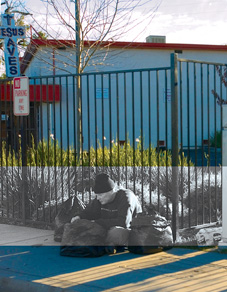 Homeless—Poorest of the Poor Homeless—Poorest of the Poor
The homeless, says sociologist Dean MacCannell, are a lot like the rest of us—with dreams of a decent job, good home and a nice vacation. The difference is that “their relationship to the world is broken, usually by a drug or alcohol problem.”
In surveys of adults living in shelters and on the streets in the greater Sacramento region, MacCannell, colleagues and students have also found high rates of mental illness, most often a form of depression. Many were victims of childhood abuse.
“What you find in the homeless are people who have been let down by their families and society, or feel that they have been,” said MacCannell, who described the homeless as the “bottom slice of the poor population.”
MacCannell, an environmental design professor best known for a classic book about tourism, became UC Davis’ first rural sociologist when he joined the faculty in 1975. He conducted the first county-by-county poverty profile for the state of California in 1981, documented a link between large-scale farms and farmworker poverty and worked for the federal government on issues of agriculture and poverty.
Working with a consulting firm started by former graduate student Sergei Shkurkin, M.S. ’97, MacCannell has also advised Hmong and Russian immigrant self-help organizations, helped develop a new homeless shelter and treatment center in Woodland and conducted homeless surveys in Yolo, Sacramento and Placer counties.
Those surveys found two types of homeless adults: those who stay in shelters and accept counseling, drug testing and other services, and a smaller but more visible group that rejects services, dislikes the rules and regulations of shelters and prefers to live outdoors. “The homeless population is actually three times as large as what most people see,” MacCannell said.
A survey in 2000 found that the most common homeless person in Yolo County was a 5-year-old white girl.
In a 2002 Placer County survey, teams of UC Davis students, including MacCannell’s son, Jason, Ph.D. ’05, counted 405 homeless people—88 of them children—and conducted in-depth interviews with 271 of the adults. Dean MacCannell believes the survey is one of the most comprehensive of its kind in the nation.
The findings refuted notions of the homeless as transients drawn to the area by public services or handouts. In Placer County, the typical homeless adult was a 41-year-old white man who lived in the area longer than many residents of fast-growing, affluent communities.
Among other Placer County findings:
• About 11 percent worked at least part-time, about half the rate found among Yolo County homeless.
• Most had little or no work history, though those who had previously been employed included an airline pilot, legal secretary, nursery owner, computer technician and a $200-an-hour model.
• Nearly nine out of 10 indicated current or past problems with alcohol or drugs.
About half suffered from mental illness, most often depression.
• Nearly one in four had been abused physically or sexually as a child.
• Thirty percent dropped out of school before 12th grade, compared to dropout rates as high as 80 percent found in homeless populations elsewhere in the country.
• Asked about their dreams and aspirations, 34 percent said they would like to find work or a better job, 30 percent said a stable home and 28 percent, a vacation. Only 10 percent said they were happy just as they were.
Related stories:
The New Rural Poor
Mention poverty and many people think of the inner cities. But a number of small Central Valley towns have poverty rates rivaling those found of the poorest neighborhoods of Los Angeles and Oakland. [more]
Students Help
Tu Tran Huynh was deeply touched by the homeless children she met as a high-school volunteer at Sacramento’s Loaves and Fishes dining hall. She wanted to do more to help, so as a sophomore at UC Davis she co-founded a student organization to advocate for the local poor. [more]
The Poor Get Poorer
Since 2001, the U.S. economy has been growing and the standard of living going up, but more than 4 million more Americans have slipped into poverty. Three UC Davis economists recently took a closer look at the reasons why and found the answer lies largely in a growing wage gap. [more]
The Compassion Gap
Hurricane Katrina exposed more than the face of poverty in the United States, says sociologist Fred Block. It also revealed a historic schism in American attitudes—a “compassion gap” between traditions of helping and blaming the poor. [more]
Back to introduction, Poverty in the Land of Plenty,

Kathleen Holder is associate editor of UC Davis Magazine. Photos by Karin Higgins/UC Davis.
|

